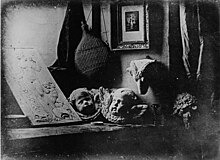A dauerrotype is the silver plate that resembles a mirror. The silver forms a thin layer of silver that when angled correctly can change a black and white image into color. The materials and developing process was out in the public by 1839. Dagueerotypes replaced the process of camera obsucra tracing and allowed people to take still pictures in less than 20 minutes.


2. What is an "albumen" print? What was the main "ingredient" of the albumen process? When did the albumen process die out?
An albumen print is a silver sheet that is dipped in egg to create a type of lamenate, this process headed downward in the 1890's and the beginning of the 20th Century.


3. What is a "stereograph?" When were they popular?
A stereograph is two side by side images that when viewed through a special finder, can create a 3-D image. The big demand rush started in the 1850's.


4. What is a "carte de visite?" What were they used for?
A small image that is about the size of a post card, similar to the ones we see today. They were traded among friends and family much like we do today (only not online, but rather in person).

5. Who were Matthew Brady and Alexander Gardner? They both are notable for what type of photography? When were they active?
Matthew Brady and Alexander Gardner were photograpers who took images of battles and the outer world and then sold the negatives to companies who created books and magazines that went out to the pubilc so they knew what was going on. They were active during the the 1860's and the both managed to capture gruesome scenes of war battles.




